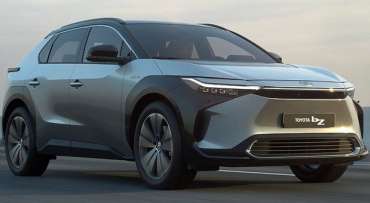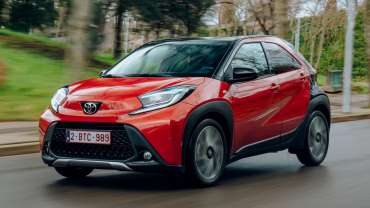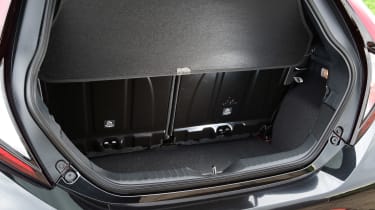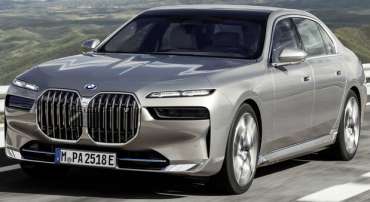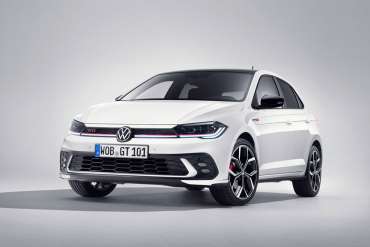
World Car Blog
Toyota remains without subsidies for EVs
Toyota joins Tesla and General Motors, which have already lost access to subsidies after hitting a sales cap.
More expensive vehicles for consumers
Toyota is the latest automaker to lose federal tax credits in the US and will join Tesla and GM, companies that have already lost their eligibility for $7,500 in subsidies. According to Bloomberg reports, the company exceeded the qualifying sales threshold for EVs and hybrids in June.
The government has limited each car manufacturer to a value of 200,000 tax credits for electric vehicles. Toyota and other companies are lobbying for the limit to be lifted. Toyota says the loan loss will mean its electric cars will be more expensive for consumers. It will certainly slow the transition from cars with internal combustion engines to electric vehicles.
Toyota and Tesla backed out of the Biden administration's plan to provide additional loans to unionized automakers. GM, Ford and Stellantis have union factories. Also, the Build Back Better bill, pending in the Senate, included additional credits for cars made entirely in the US.
For now, the tax credits used by Toyota will be phased out over a one-year period. According to reports, the value of the subsidies will be halved before the final abolition. However, Toyota will still be able to take advantage of state-level incentives.
Toyota Aygo X hatchback review
Pros
- Affordable
- Smooth ride
- Well equipped
Cons
- No electrification
- Cramped rear seats
- Sluggish acceleration
The Toyota Aygo X (pronounced Cross) is the Japanese giant’s bet on the future of the city car; a small, nippy hatchback with the styling of an SUV and raised suspension. It looks ideally suited to Britain’s often less than ideal roads, which are strewn with potholes and speed bumps.
It’s still instantly recognisable as an Aygo, but now with even more expressive headlights, tough, fashionable body plastic cladding and large 17- or 18-inch alloy wheels pushed as far to each corner of the bodywork as they’ll go. But with the upgrades comes a price hike, and it remains to be seen if first car buyers and city car shoppers on a budget will stump up the extra cash.
This is a bold, contemporary look, but Toyota has been rather more conservative in other areas. While there are bright coloured pieces of trim around the infotainment touchscreen and gearlever, you’ll also find an analogue instrument cluster and plenty of hard, durable plastics. In other words, it’s a reminder that the Aygo X starts from around £15,000 – a price point where manufacturers struggle to make a profit nowadays.
Under the short bonnet of the Aygo X’ there’s an evolution of Toyota’s tried-and-tested 1.0-litre three-cylinder petrol engine – with no hybrid or all-electric version on the horizon. It’s a traditional take on the city car formula, that keeps the cost of buying or leasing the Aygo X very low, and will prove cheap to run for private buyers. However, its tailpipe emissions of just above 100g/km won’t make it as appealing for business users as an EV like the electric Fiat 500, Honda e or MINI Electric. Official fuel-efficiency figures are between 57.6 and 60.1mpg.
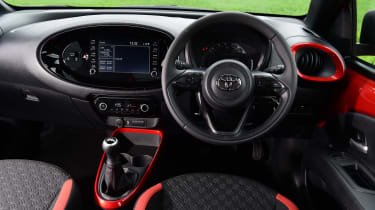
On the road, the Aygo X has light steering and its slightly raised view out feels like an advantage on congested city streets. The raised suspension feels like a net gain too, because while it has slightly more lean in tight corners, it’s better at soaking up bumps. Its engine feels rather old fashioned, though, with a fairly loud thrum under acceleration that’s characterful, but not especially relaxing with either the five-speed manual or CVT automatic gearbox.
The Toyota Aygo X is a comfortable and fun city car that feels much more contemporary inside, thanks to the latest technology. However, the extra price it commands following its SUV makeover might price it out of the first-car market, and it’s a shame it misses out on Toyota’s excellent hybrid technology.
Unlike many rival manufacturers which are launching electric superminis like the Fiat 500, Toyota is sticking with a small petrol engine for the Aygo X. While this doesn’t have the stark running cost advantages, it does ensure the small Toyota is relatively affordable to lease or buy.
Toyota Aygo X MPG & CO2
There is no choice of powertrains in the Aygo X – your only decision is whether to specify the 1.0-litre three-cylinder engine with a five-speed manual or a CVT automatic gearbox – the former returns up to 60.1mpg and emits 107g/km of CO2, while the auto gets 57.6mpg and 110g/km. During our test drive we saw just 40.1mpg on the trip computer. For this reason, we’d say the manual is a better bet unless you really need the ease of an automatic in urban traffic.
Emissions of just over 100g/km mean the Aygo X sits in a middling Benefit-in-Kind band for company-car drivers.
Insurance groups
The Aygo X wins back points for being cheap to insure; entry-level manuals sit in the frugal insurance group 5, while even fully loaded automatic cars only reach group 7. Its VED (road tax) bill will also be the standard amount for combustion-engined models, keeping additional costs to a minimum.
Warranty
Following the standard three-year/60,000 mile warranty, the Aygo X also qualifies for Toyota’s ‘Relax’ warranty, which can cover the car for up to 10 years/100,000 miles, and is activated each time the car is serviced at a Toyota dealership; if you’re happy to stick to these terms, it’s even longer than the seven-year warranty offered with the Kia Picanto.
Servicing
For £15 a month Toyota will provide the first three services and roadside assistance for three years.
The Toyota’s quasi-SUV looks aren’t just for style, they also affect the driving experience. Nipping through city traffic, the raised driving position means you feel like the view out is slightly better than in rivals (the driver’s seat is 55mm is higher than before), and light, quick steering makes it easy to confidently drive through narrow gaps and make lane changes.
There’s a small amount of body lean to remind you of the taller ride height, but the Aygo X handles in a neat and reassuring fashion, so you can tackle a winding road without the car feeling out of its element. It’s clear the new underpinnings from the Toyota Yaris have made the Aygo X feel more mature to drive all-round than the outgoing car, which sometimes felt a little insecure at higher speeds.
Toyota Aygo X petrol engine
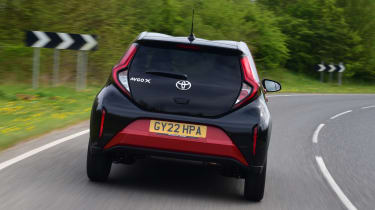
Those hoping for a smaller, funkier version of the Toyota Yaris Cross SUV will be disappointed, because the Aygo X forgoes that car’s frugal hybrid powertrain. Instead, the Aygo is only available with a somewhat outdated-feeling 1.0-litre three-cylinder engine which lacks any kind of hybrid assistance.
This produces 71bhp and while that may seem pretty slow, it is well suited to nipping around busy city streets. Under acceleration, the thrum of the engine can be obtrusive; this is something you’ll hear often as getting up to speed takes a lot of effort. The sprint from rest to 62mph takes a leisurely 14.9 seconds – nearly six seconds slower than the electric Fiat 500.
In the Toyota, buyers have the choice of two transmissions: a five-speed manual or a CVT automatic gearbox. The former is slick enough, with the lack of a sixth gear a clear indicator that this car is not really intended for motorway driving. The CVT ’box adds somewhat to refinement, but it’s not the best of its ilk, which makes getting up to speed even more of a chore.
Most city cars are fitted with small wheels and cost-saving suspension, so they can struggle with potholes and speed bumps, but the Aygo X does well here. Its new underpinnings and raised ride mean it soaks up rough surfaces as well as a car from the class above, making it ideal for Britain’s pockmarked streets. There’s a bit of wind and tyre noise at higher speeds, but on the whole, the Aygo X feels solid.
Toyota Aygo X dashboard
Toyota has designed the Aygo to be cheerful, with lots of oval shapes and some colourful trim for the air vents and touchscreen surround to keep it youthful. But it’s also clear this is a car built to have an affordable price tag, with reminders like the hard plastics and exposed metal on the door panels and some of the dashboard. Happily, Toyota does a good job of making these materials feel like they’ve been chosen to be durable, not just to save pennies. We also think the physical climate control dials are far easier to use while on the move than a touchscreen solution.
The touchscreen itself starts off as a seven-inch display and rises to a nine-inch unit in top-spec models. All versions get Apple CarPlay and Android Auto functionality, which is good because Toyota’s system can be a touch laggy at times. Unfortunately, there is no fully digital instrument cluster behind the steering wheel; the Aygo X instead gets a four-inch colour display that can show a small handful of read-outs such as the time, the car’s fuel economy and the current speed.
Equipment
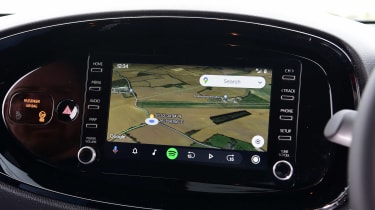
Buyers have the choice of four trim levels when configuring their Aygo X: Pure, Edge, Exclusive and Limited Edition. Starting from around £15,000, Pure is the entry-point into the range, yet still provides a decent level of standard equipment. This includes 17-inch alloy wheels, adaptive cruise control, forward collision warning, lane-keep assist, air conditioning, a reversing camera and the seven-inch touchscreen with Apple Carplay and Android Auto.
Edge trim adds two-tone paintwork, larger, 18-inch diamond-cut alloys, an eight-inch touchscreen and automatic climate control. Stepping up to the Exclusive model, there’s a nine-inch central touchscreen, LED headlights, keyless entry and start, front and rear parking sensors, wireless phone charging and a collision avoidance system. Finally the Limited Edition model gets an exclusive green and orange paint job with gloss black wheels, as well as a JBL sound system, privacy glass, heated front seats and an electrically retractable canvas roof – which turns the Aygo X into the cheapest convertible on sale.
Options
There are few options available for the Aygo X, with most equipment coming as part of different trim levels. Lower-spec cars can be fitted with front and rear parking sensors for around £300, while the novel canvas roof will set you back roughly £900. Aygo X Exclusive cars can be fitted with the JBL sound system for £500, while the only remaining optional extra is the CVT automatic gearbox, which costs just over £1,000 more than the manual.
Analysts have very different views on Tesla's prospects
Elon Musk on Friday backed away from his $44 billion takeover proposal for Twitter.
Twitter announced the lawsuit, sending its shares down six percent in after-hours trading on Friday. Tesla shares are up ten percent in the last seven days, but forecasts are very different.
Deutsche Bank believes their price is still attractive despite supply chain issues, raising their price target to $1,125.
Analysts at JPMorgan think otherwise, lowering their price target to $385, as inflation reportedly erodes Tesla's profits significantly.
Armored BMW i7 announced
Green-minded politicians and celebrities won't have to change their conservation values any time soon as BMW has announced plans to offer an armored i7.
The model will be presented next year and promises "a new and innovative concept of protection" as well as "an unrivaled combination of protection, balance and safety as well as spaciousness and sustainability". BMW President Oliver Zipse said that the company "will present a fully electric vehicle with high safety for the first time - without compromise when it comes to the standard of protection for our customers". He added that the model will show that "sustainability and safety can go hand in hand".
Although many questions remain open, it is known that the i7 xDrive60 uses an all-wheel drive system with two electric motors producing a combined output of 543 hp (400 kW) and 744 Nm. This allows it to accelerate from 0 to 96 km/h in about 4.5 seconds and a range of an estimated 483 km with one charge in the EPA test cycle, reminds Jutarnji.hr.
It will be interesting to see how much the reinforcement process will affect the car's range, but BMW has decades of experience with these types of vehicles. Their first armored car was introduced in 1978 and was based on the 7 Series. Subsequent generations of flagship sedans offered armour, while the X5 Security was added to the range in 2004.
It remains unclear what level of protection the i7 will have, but BMW has previously offered the VR6 and VR7 vehicles. The X5 Protection VR6 was equipped with cast armor, an armored trunk compartment and bullet-resistant glass approximately 33 millimeters thick.
Volkswagen Polo GTi review
PROS
- Plenty of performance
- Comfortable and easy to live with
- Well equipped and well priced
CONS
- Rivals more exciting to drive
- Loses composure at higher speeds
- Too many touch-sensitive controls
If you want a genuinely fast supermini without the compromises, the Volkswagen Polo GTI could well be for you. For while the Ford Fiesta ST and Hyundai i20 N are very exciting small cars to drive, their firm suspension and always-on attitude, can make them quite difficult to live with.
VW has been building go-faster versions of the Polo for decades, but they’ve always felt like the slightly poor relations in comparison to the seminal Golf GTI. However, when the current generation of Polo GTI first launched in 2018 we were left more impressed than we expected, thanks to a capable chassis and plenty of punch from the 200hp 2.0-litre turbo engine.
On sale from 2022 is a refreshed version of this hot hatchback, with mildly made-over looks and some small technical changes. Power output is now 207hp, accompanied by 320Nm of torque that arrives in a lump that’s available all the way from 1,500 to 4,500rpm, and driving the front wheels via a seven-speed DSG automatic transmission. The standard equipment list gains Volkswagen’s adaptive IQ.Light LED matrix headlights and an illuminated grille crossbar.
What’s it like inside?
There was a time when entering the cabin of a Volkswagen Polo was like dropping into a black hole, but this latest model has always bucked that trend with brightly coloured dashboard inserts. In the GTI’s case, you get Kings Red Glossy as standard – though if this is a bit much, Deep Iron Glossy is also an option.
The candy red finish is certainly eye-catching. But it also appears to be a slightly different shade to all the other red GTI detailing you’ll find inside and out. As if a couple of different departments weren’t talking to each other.
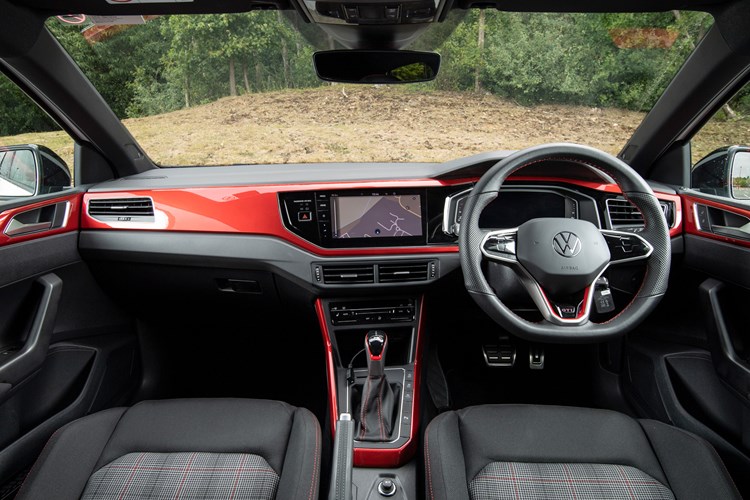
Still, at least the seats are smart, with their sporty bolsters and ‘Jacara check’ pattern, famous from other Volkswagen hot hatches. Plus, the build-quality feels very good throughout. The black headlining is another typically sporty touch, though some buyers may find it adds a claustrophobic air to the interior.
Worse, as with most modern VWs, the Polo GTI is plagued with touch-sensitive controls in place of conventional switches and buttons – including for fairly fundamental items such as the air-conditioning system. You get used to this approach, but it still seems like change for change’s sake and simply isn’t as straightforward to deal with when driving.
The infotainment system works well enough, however. The Polo GTI gets satellite-navigation as standard, alongside Android Auto and Apple CarPlay, DAB radio, and a host of other connectivity features; an 8.0-inch touchscreen is standard but you can pay extra for a 9.2-inch touchscreen that fills the space on the dashboard better and comes with a number of extra features.
The latest digital instrument cluster – Digital Cockpit Pro – has a higher resolution, greater contrast and deeper colours, making it nicer to use.
Comfort
We’ll get to the suspension in the driving section below – here let’s quickly deal with the other comfort features. Standard sports seats not doing it for you? Then you can opt for ‘sports comfort’ seats instead, though these are finished in ArtVelours instead of the classic GTI tartan of the regular chairs.
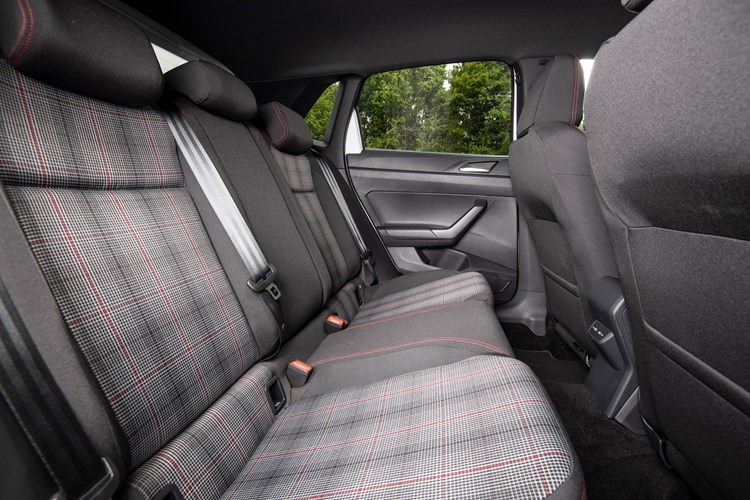
There’s plenty of room for adults in the front. The rear is less generous, so while the five-door body makes access easy enough and the back doors open impressively wide, head and leg room is tight. This is a small car. Hard not to expect that.
Road noise is well suppressed, and there’s not much wind or engine noise, either – and although the Sport driving mode does make it sound a little louder, this is still far from intrusive.
Safety
Safety kit includes curtain airbags and a new centre airbag to stop passengers colliding during an impact, autonomous emergency braking, and road-sign recognition. The Polo GTI will also jam its brakes on after a crash in an effort to stop secondary collisions, and comes with Volkswagen’s Travel Assist function that delivers modest assisted driving capability, including lane keeping assist.
More traditional electronic driver aids include the usual ABS and ESC as well as Volkswagen’s long-standing XDS electronic differential lock (sometimes also referred to as the EDL), which helps to maximise traction during cornering.
There are three Isofix mounts for child seats: one on the front passenger seat and each of the outer rear seats. This Polo has a five-star Euro NCAP crash safety rating, but it dates back to 2017 – the test is now harder and the car has been facelifted, but we wouldn’t anticipate any major failings in this area.
What’s it like to drive?
The phrase that first springs to mind is ‘very grown up’. This is a compact car with a big engine, so it very rarely feels stressed. It also has a (generally) smooth and swift-shifting automatic transmission – which won’t allow you to hit the limiter, even in manual mode – and far better ride comfort than any of its rivals.
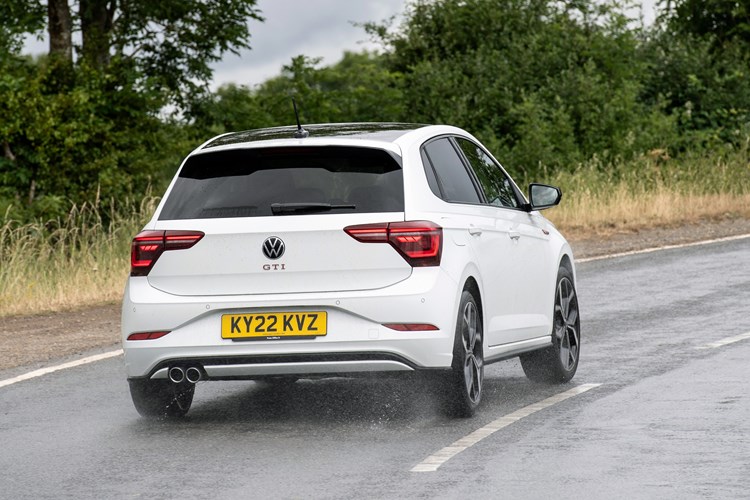
Thus the Polo GTI will almost certainly be a very easy car to live with. No wincing here if you need to take your grandmother to the shops, for instance – whereas in a Fiesta ST you could be genuinely worried they might rupture something, given the hard ride of that car and the state of some of our urban road surfaces. Despite being 15mm lower than a normal VW Polo, the GTI really can smooth out the worst of the rough stuff.
It’s quick, too. The quoted 6.5-second 0-62mph time may only match the aforementioned ST’s on paper, but in practice, the Polo’s seven-speed DSG transmission will make this much easiest to routinely achieve than the Fiesta’s occasionally clunky six-speed manual gearbox. Top speed is slightly higher at 149mph versus 144mph, but that’s probably less relevant than the substantial, easily accessed mid-range muscle the VW’s larger engine delivers.
The question is whether this rapid but relaxed progress is really what you want from a supermini-sized hooligan. There’s a clear argument to be made here that for all its polish, the Polo GTI isn’t quite exciting enough. Competent – yes, hugely. But much of the time this feels more like a small car that happens to be fast rather than eyes-wide thrill ride.
The steering, for example, while precise, doesn’t give you much in the way of feedback. This can in turn – no pun intended – lead to the front of the car feeling less incisive than the rival Fiesta’s. You can cure this to a certain extent by braking into the corner, rather than on the way to it, which helps the Polo get its nose rotated. But there is nothing like the agility that the ST exudes in every moment.
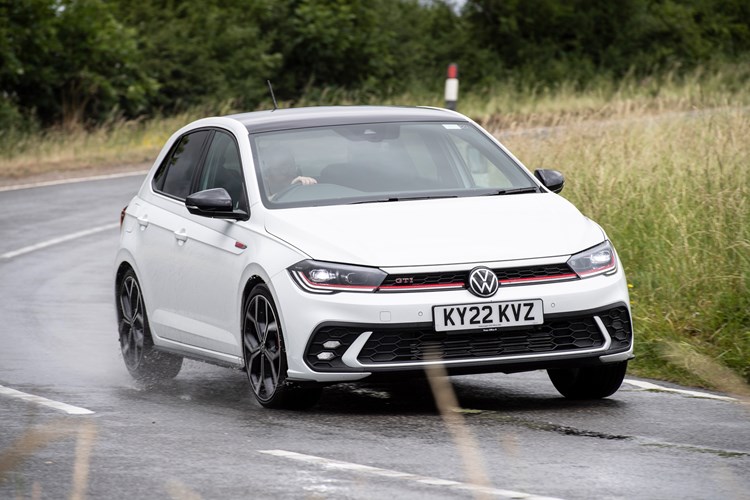
Similarly, while the body control is hardly poor, in the regular suspension setting it does start to become a little floaty over crests and bigger bumps as you go faster. UK GTIs come with adjustable damping as standard, and the firmer Sport setting does gather things back into hand. But the cost is a brittleness that’s fine on smooth racing circuits but less suited to British B-roads, meaning we found ourselves reverting to the normal mode and driving slightly slower.
What models and trims are available?
The Polo GTI is available as a single variant, sitting at the top of the Volkswagen Polo range. Standard equipment includes not only the sat-nav, infotainment system and air-conditioning mentioned above, but also parking sensors, automatic lights and wipers, adaptive cruise control, and an auto-dimming rear-view mirror.
Personalisation options include a black roof finish in combination with the red, white and blue exterior paint colours. Black and grey paint choices are also offered, as is an upgrade from 17-inch to 18-inch alloy wheels (pictured here).
What else should I know?
Visual changes for the 2022 Polo GTI facelift include a new rear bumper treatment – the previous version looked too much like the standard car from behind.
As well as a pair of USB-C ports in the front that link to the media system, there are also two more in the rear. The latter are for charging only, but this should keep your passengers happy.
The Volkswagen Polo GTI is fast, comfortable and mature. It seems well built and the sporty styling touches are restrained enough for the most part that you don’t feel like you’re making an exhibition of yourself while still attracting approving glances from people in the know.
We have no hesitation recommending it to anyone who wants a small car that’s effortlessly rapid and doesn’t demand you make excuses to your passengers whenever the road surface gets a little rougher. As a daily driver without major compromises, no other supermini-sized hot hatch comes close.
However, both the Ford Fiesta ST and the Hyundai i20 N are more fun for enthusiastic drivers. So consider your priorities carefully before heading to the VW dealer.
What we like
The Polo GTI is more rounded in character than any rival while giving away nothing when it comes to raw performance. The DSG transmission and adaptive suspension make it easy to live with, and it comes with plenty of standard kit.
What we don’t like
Competitors are more composed at higher speeds as well as more agile and engaging to drive. Far too many touch-sensitive controls in place of proper buttons.
Bentley Bentayga Equestrian Collection
The Bentley Mulliner division continues to roll out special editions for select customers from different parts of the world.
As reported by Carscoops, the latest example is the Equestrian Collection, with a limited run of ten Bentayga units reserved for Belgium.
As the name suggests, the new series was commissioned to celebrate the world of equestrian sports in Belgium. That's why the theme is inspired by horses and the art of jumping. The special Bentayga is painted in a unique Specter exterior shade, paired with a set of 22-inch ten-spoke black wheels, carbon fiber accents and a special C-pillar badge. The latter is the symbol of the Stephex Masters, with an orange graphic depicting the heads of two horses.
The same emblem can be found on the seat backs and cushions inside the cabin. Mulliner chose Burnt Oak for the fine leather upholstery, with contrasting tangerine stitching. In addition to the seats, a diamond-shaped pattern can also be found on the door inserts.
Another unique detail is the "Belgian Equestrian Collection" lettering on the dashboard veneer. Of course, each of the ten examples can be further personalized by the owner in collaboration with Mulliner, favoring the use of sustainable materials.
All examples of the Belgian collection are based on the Bentayga V8 version. This means that they are equipped with a 4.0 liter V8 twin-turbo engine with 404 kW/550 hp and 770 Nm of torque. Power is sent to all four wheels via an eight-speed automatic transmission.
Those interested in purchasing one of the ten examples should visit the dealerships in Antwerp, Brussels and Knokke. The SUV will be presented during the Brussels Stephex Masters competition, which takes place from August 24 to 28.
Renewed Lexus ES for Europe
The sixth-generation Lexus ES was introduced in 2018 and underwent a facelift in 2021. However, things have moved on on the technology front since then, with Lexus introducing its latest infotainment system in models such as the RX, NX and UX.
So the European ES also now benefits from a faster unit that is easier to use and has more features. Lexus hasn't revealed the size of the center touchscreen, but it's likely to be 12.3 inches like other models in its lineup, according to Carscoops.
The system brings wireless Apple CarPlay connectivity, although for some reason Android Auto still requires a wired connection. There's also cloud-based navigation that displays real-time updates on traffic, fuel prices and parking.
The voice recognition system has also been revamped and is compatible with 19 different European languages. A new data transmission module (DCM1) allows the ES to connect to mobile networks and the Internet, as well as to integrate the e-Care function that monitors the vehicle 24/7 and notifies the owner when service is required. The module also provides access to remote control functions via the Lexus Link smartphone app.
Lexus also redesigned the center console of the ES. It now has two cup holders, USB-A and USB-C ports. Lastly, the Ammonite Sand interior trim option is new and has replaced Rich Cream.
There are no external changes to the ES as the model was recently restyled. However, Lexus now offers an F Sport Design trim that features 19-inch black alloy wheels and F Sport Design badging on the fenders, while offering a choice of 10 exterior and four interior colors.
Available powertrain options remain the same, but the ES 300h variant will be available in additional markets (Azerbaijan, Georgia, Moldova and Ukraine).
Production of the 2023 Lexus ES model year for the EU begins in August, with first deliveries scheduled for October.

